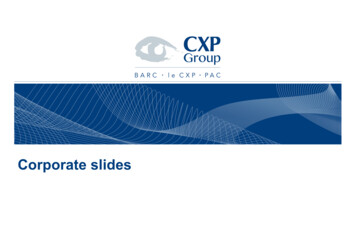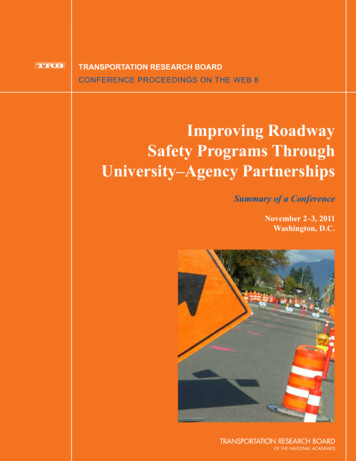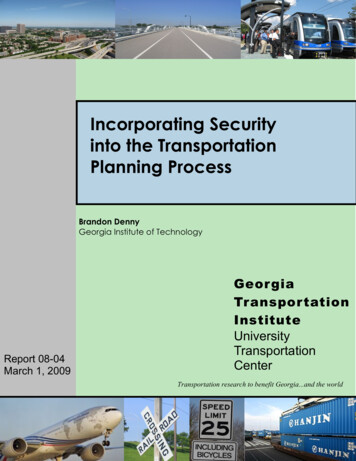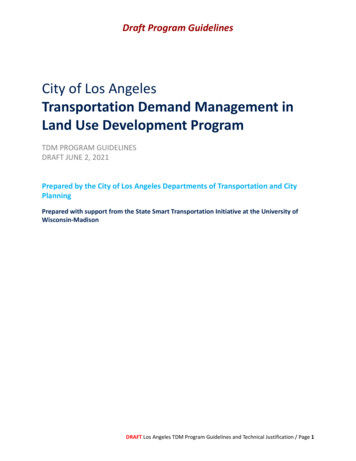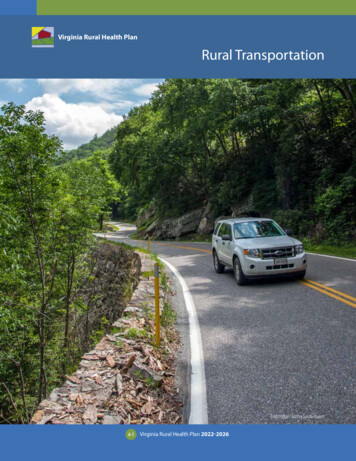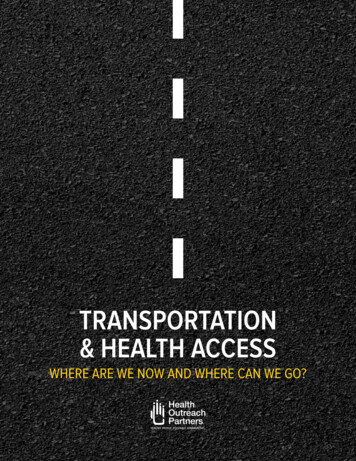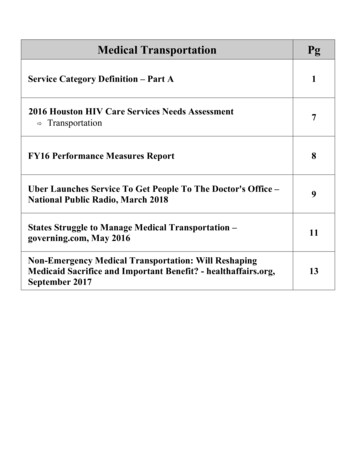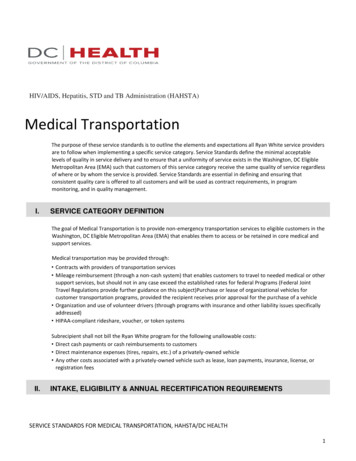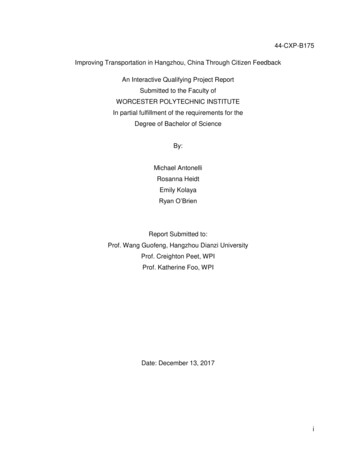
Transcription
44-CXP-B175Improving Transportation in Hangzhou, China Through Citizen FeedbackAn Interactive Qualifying Project ReportSubmitted to the Faculty ofWORCESTER POLYTECHNIC INSTITUTEIn partial fulfillment of the requirements for theDegree of Bachelor of ScienceBy:Michael AntonelliRosanna HeidtEmily KolayaRyan O’BrienReport Submitted to:Prof. Wang Guofeng, Hangzhou Dianzi UniversityProf. Creighton Peet, WPIProf. Katherine Foo, WPIDate: December 13, 2017i
AbstractHangzhou’s transportation network fails to reach its full potential because transportationplanners do not take into account citizen feedback through bottom-up planning. In order todetermine major indicators of satisfaction, as advised by Hangzhou Dianzi University Dean ofSociology, Professor Wang Guofeng, our team conducted focus groups, interviews, and asurvey with Hangzhou’s residents and transportation operators and managers. We found thatincreasing network compatibility among different transportation systems will target indicatorsreflecting low satisfaction, thereby increasing overall transportation satisfaction.ii
AcknowledgmentsOur group would like to graciously thank the following organizations and individuals for theirassistance and support throughout our project: Hangzhou Dianzi University (HDU) for providing us with a comfortable living space and abeautiful work environment during our stay. HDU Sociology Department Head, Wang Guofeng for sponsoring our project andproviding resources and contacts to conduct questionnaires, focus groups, andinterviews. Creighton Peet, our project advisor who aided and encouraged us to reach our goal byoffering his extensive knowledge of previous studies and occasional Chinese languageskills. Katherine Foo, our project advisor who guided us to improve the focus of the project andgave us insight on the current data analysis software available. 刘露 (LiuLu), 石雨菲 (ShiYufe), 刘柳 (LiuLiu), and 许芷瑜 (XuZhiyu), HDU sociologystudents, for assisting us in translation, questionnaire distribution, and helping us withdaily life in China. Annie Kids and Kid Castle English language companies, for their assistance indistributing questionnaires. Worcester Polytechnic Institute for making this experience possible. Sophomore HDU sociology students for participating in our focus groups and assistingus with translation during some interviews. All of the focus group and interview participants who graciously answered our questions.iii
AuthorshipAbstract Primary Author: WPI Team*Acknowledgements Primary Author: Emily KolayaTable of Contents Primary Author: Ryan O’BrienTable of Figures Primary Author: Ryan O’BrienTable of Tables Primary Author: Ryan O’BrienExecutive Summary Primary Author: Michael Antonelli Primary Editor: Rosie Heidt, Emily Kolaya & Ryan O’BrienChapter 1: Intro Primary Author: Rosie Heidt Primary Editor: Rosie Heidt & Ryan O’BrienChapter 2: BG Section 2.1 Defining Models of Satisfaction Primary Author: Ryan O’Brien Primary Editor: Rosie Heidt & Ryan O’Brien Section 2.2 Indicators of Transportation Satisfaction Primary Author: Michael Antonelli Primary Editor: Rosie Heidt & Ryan O’Brien Section 2.3 Transportation Satisfaction in Hangzhou, China Primary Author: Rosie Heidt Primary Editor: Rosie Heidt & Ryan O’Brien Section 2.4 Summary Primary Author: Rosie Heidt & Ryan O’Brien Primary Editor: Rosie Heidt & Ryan O’BrienChapter 3: Methodology Primary Author: Rosie Heidt & Ryan O’Brien Primary Editor: Rosie Heidt & Ryan O’Brieniv
Chapter 4: Results Primary Author: Michael Antonelli, Rosie Heidt, & Ryan O’Brien Primary Editor: Rosie Heidt & Ryan O’BrienChapter 5: Conclusion Primary Author: WPI Team Primary Editor: WPI TeamReferences Primary Author: Ryan O’Brien Primary Editor: Ryan O’BrienAppendix A: Sponsor Description Primary Author: Rosie Heidt Primary Editor: Michael Antonelli & Emily KolayaAppendix B: Physical Inspection Protocol Primary Author: Rosie Heidt Primary Editor: Rosie HeidtAppendix C: Overview of Transportation in Hangzhou Primary Author: Rosie Heidt Primary Editor: Ryan O’BrienAppendix D: Focus Group Protocols Primary Author: Rosie Heidt Primary Editor: Rosie Heidt & Michael AntonelliAppendix E: Questionnaire Iterations Primary Author: WPI Team & HDU Colleagues** Primary Editor: WPI Team & HDU ColleaguesAppendix F: Interview Protocols Primary Author: Rosie Heidt & Michael Antonelli Primary Editor: WPI TeamAppendix G: Focus Group Transcripts Primary Author: Rosie Heidt & Emily Kolaya Primary Editor: Rosie HeidtAppendix H: Interview Transcripts Primary Author: Rosie Heidt & Ryan O’Brien Primary Editor: Rosie Heidtv
Appendix I: Questionnaire Data Tables Primary Author: Ryan O’Brien*Includes Michael Antonelli, Rosie Heidt, Emily Kolaya, and Ryan O’Brien**Includes 刘露 (LiuLu), 石雨菲 (ShiYufe), 刘柳 (LiuLiu), and 许芷瑜 (XuZhiyu)vi
Table of ncludes Michael Antonelli, Rosie Heidt, Emily Kolaya, and Ryan O’BrienviTable of ContentsviiTable of FiguresxTable of TablesxiExecutive SummaryxiiChapter 1: Introduction1Chapter 2: Background42.1 Defining Models of Satisfaction42.2 Indicators of Transportation Satisfaction62.3 Transportation Satisfaction in Hangzhou, China92.4 SummaryChapter 3: Methodology3.1 Identifying Sectors of the Hangzhou Transportation System3.1.1 Conducting a physical inspection3.2 Determine Levels of Satisfaction in Hangzhou with Transportation11121213143.2.1 Conducting the focus groups143.2.2 Surveying163.2.3 Semi-Structured Interviews183.3 SummaryChapter 4: Results and Analysis4.1 Incompatibility in Hangzhou’s Transportation Systems1820204.1.1 Metro System and Bus Line Competition214.1.2 Shared Bike Incompatibilities274.1.3 Road Traffic Interactions314.1.4 Water Transit344.2 Compatibilities4.2.1 Taxis and Didi Cars3535vii
4.2.2 Hangzhou Transportation Cards374.2.3 Bikes as Second Leg384.2.4 Bus and Metro Compatibilities404.3 Overview of Limitations and Considerations40Chapter 5: Conclusions and Recommendations425.1 Compatible Metro and Bus System425.2 Walkways and Bikes435.3 Road Travel and Traffic Laws445.4 Further Study455.5 Summary45References47Appendix A: Sponsor Description53Appendix B: Physical Inspection Protocol55Appendix C: Overview of Transportation in Hangzhou561. Metro562. Water Transit593. Buses624. Shared Bikes645. Hired Cars66Appendix D: Focus Group Protocols68Appendix D1: Focus Group Protocol Version 168Appendix D2: Focus Group Protocol Version 270Appendix E: Questionnaire Iterations73Appendix E1: Initial Questionnaire73Appendix E2: First Iteration79Appendix E3: Second Iteration81Appendix F: Interview Protocols85Appendix F1: Bus Driver Interview Questions:85Appendix F2: Bus Operator Interview Questions:86Appendix F3: Ofo Manager Interview Questions:86Appendix F4: Didi Taxi Driver Interview Questions:86Appendix F5: Taxi Driver Interview Questions:87Appendix G: Focus Group Transcripts88viii
Appendix G1: Faculty Focus Group Transcript88Appendix G2: Student Focus Group Transcript93Appendix G3: Boye Focus Group Transcript96Appendix H: Interview Transcripts100Appendix H1: Didi Driver Interview Transcript100Appendix H2: Taxi Driver Interview Transcript102Appendix H3: Bus Driver and Operator Interview Transcript104Appendix H4: Ofo Worker Interview Transcript106Appendix I: Questionnaire Data Tables108ix
Table of FiguresFigure 1: Hangzhou Current Metro MapFigure 2: Hangzhou Planned Metro MapFigure 3: Metro vs Bus Weekly UseFigure 4: Metro Speed SatisfactionFigure 5: Bus Speed SatisfactionFigure 6: Metro Crowdedness SatisfactionFigure 7: Metro vs. Buses: Usage by Distance TraveledFigure 8: Shared Bike Weekly UseFigure 9: Shared Bike OvercrowdingFigure 10: Shared Bike Condition SatisfactionFigure 11: Public Bike StationFigure 12: Public Bike Quality SatisfactionFigure 13: Car Parking SatisfactionFigure 14: Car Traffic SatisfactionFigure 15: Taxi Wait Time SatisfactionFigure 16: Payment Method Usage FrequenciesFigure 17: Shared Bike Trip Distance FrequenciesFigure 18: HDU Hierarchy (HDU 2017)Figure 19: Grand Canal Cruise BoatFigure 20: Inside Grand Canal Cruise BoatFigure 21: Hangzhou Bus InteriorFigure 22: Ofo Bikes in WalkwayFigure 23: Shared bikes in 365x
Table of TablesTable 1: ‘Importance Factor’ of IndicatorsTable 2: 1 km Travel Method FrequenciesTable 3: 2-5 km Travel Method FrequenciesTable 4: 6-10 km Travel Method FrequenciesTable 5: 10-25 km Travel Method FrequenciesTable 6: More Than 25 km Travel Method FrequenciesTable 7: Commute Travel Method FrequenciesTable 8: Leisure Travel Method FrequenciesTable 9: Bus Speed SatisfactionTable 10: Bus Weekly Use FrequenciesTable 11: Metro Speed SatisfactionTable 12: Metro Crowdedness SatisfactionTable 13: Metro Weekly Use FrequenciesTable 14: Shared Bike Weekly Use FrequenciesTable 15: Shared Bike Condition SatisfactionTable 16: App Taxi Speed SatisfactionTable 17: Private Car Cost SatisfactionTable 18: Private Car Traffic SatisfactionTable 19: Private Car Parking SatisfactionTable 20: Private Car Weekly Use 2112113113113114114xi
Executive SummaryCitizen satisfaction is integral to the successful planning and development of urbaninfrastructure. Gathered feedback helps city officials understand where improvements can bemade, as well as where time and resources should be allocated. Transportation is an especiallyimportant area of development needing citizen feedback because of its prevalence in the dailylives of the populace. However, recent city planning by the Chinese Ministry of Transport hasnot adequately accounted for public opinion when developing and maintaining transportationinfrastructure. Current systems have been designed for efficiency, but previous studiesdemonstrate that overlooking public opinion can be detrimental to city growth and development.It is essential for managers of transportation systems to receive and implement feedback fromfrequent users, as they may better understand where the system falls short of expectedperformance. In this project we applied social science research techniques to determine citizensatisfaction levels regarding Hangzhou’s transportation network to make recommendations forimprovements.In order to complete our goal, we created three overarching objectives: 1) characterizeHangzhou’s public transportation network, 2) determine the public’s satisfaction level with thecity’s network, and 3) identify where improvements can be made. Before sampling, wedetermined a model of satisfaction based on a number of indicators gathered from both ourliterature review and experiential observation. These indicators formed the basis of ourargument and allowed us to analyze both qualitative and quantitative data using the samecriteria. We determined the public’s satisfaction level primarily by conducting four focus groups,which was supplemented by a survey using convenience sampling. Finally, following dataanalysis we identified relationships among the various aspects of transportation satisfaction todetermine one central argument to improve the entire network as supported by public opinion.xii
While Hangzhou’s transportation systems may function adequately on their own, wehave concluded that the biggest deficiency is a lack of overall network compatibility, or thecohesiveness and interconnectivity among these systems. Based on this, we have established anumber of findings addressing areas of incompatibility and have made correspondingrecommendations. The first of these findings is competition and redundancy between the metroand bus systems. Respondents were more satisfied with the metro’s speed and reliability, butwere less satisfied with crowdedness when compared to that of buses. Due to potentialovercrowding, which both systems experience near in peak hours, we do not recommend acomplete reliance on the metro for mass transit in Hangzhou. The most effective solution wouldbe to design future bus lines with the planned expansions of the metro in mind. Integrating thesesystems will dramatically increase overall transportation satisfaction.Through our study we discerned dissatisfaction resulting from an overabundance ofshared bicycles blocking public sidewalks and bike lanes, particularly where they impede uponother methods of transport. While prioritizing quantity over quality allows the shared bike systemto function smoothly, it only exacerbates the problematic number of bikes. In order to integratebikes with the rest of the systems in a comprehensive way, parking for bikes should beregulated and unused bikes must be removed by the companies that own them. Bike zonesshould be strategically placed near stations of other modes of transport so that they may serveas the final leg of a trip. Public bikes, also referred to as government bikes, avoid the problemsthat shared bikes create, but restrictions created by their stations reduce convenience andpublic use. A new hybrid bike system that combines the desired qualities of government bikesand shared bikes would help solve the dissatisfaction with walkways being blocked. In thissystem, geofencing technology will prevent users from locking bikes outside of specified areas.This hybrid bike system would properly fulfill public demand for convenient, cheap travel forshorter distances. With or without the proposed hybrid system, greater regulation and morecareful distribution of bikes is necessary to increase compatibility. Further research on locatingxiii
areas with more shared bicycle use would enable more efficient placement, particularly nearcrucial areas like metro and bus stations as the systems expand.Our final primary finding states that parking and traffic problems are closely tied to ageneral disregard to traffic law, especially among pedestrians and smaller vehicle users. Withthe rapidly expanding metro, all nine districts will become more accessible, increasing bothdemand for public transportation and a need for a stricter enforcement of traffic laws. In order todecrease congestion, we recommend Hangzhou’s city planners make its residents more awareof current traffic laws and enforce them more consistently. In areas of higher traffic, efficiencycan be increased greatly by introducing pedestrian bridges or underpasses, as crosswalks filledwith pedestrians dramatically slows travel time. Additional research may be beneficial indetermining strategies to alleviate congestion as urban areas of Hangzhou become moreaccessible with the growing metro system.In conclusion, using our indicator system that we developed from a combination ofliterature and experimental research, we determined that Hangzhou residents found cost,convenience, and travel time to be the most important factors of transportation satisfaction. Inorder to increase satisfaction, and in turn accommodate Hangzhou’s rapid growth, thetransportation network must be compatible. Incorporating the needs of the public into futuredesign and management will make the network more efficient and increase citizentransportation satisfaction.xiv
Chapter 1: IntroductionIncorporating public opinion into city growth is integral to identifying meaningfulimprovements in a city’s infrastructure, environment, and livability. Consequently, failing toadequately address citizen satisfaction can hinder long-term city development (U.S. Departmentof Transportation, 2004). In particular, public transportation systems directly impact the public’swell-being and perception of the city. The transportation network supports frequent use by all,as most people must travel daily. As such, it is important for city planners to create and maintainthese systems in order to best serve their citizens and implement meaningful improvements.This can increase safety and security, provide an environment for businesses to thrive, andattract more tourists and residents.Similar to many other Chinese cities, Hangzhou primarily pursues development in a topdown manner; whereby planning experts generate, develop, and implement their own ideas withminimal feedback from the local populace. Hangzhou is rapidly growing, as evidenced by itsexpanding metro system which plans to join all nine districts by 2022. The city’s publictransportation is at a pivotal stage of its development, with the recent introduction of new modesof public transportation and significant ongoing changes to infrastructure. Areas in need ofimprovement as observed by the public will not reach the city planners, and issues will oftenremain unresolved until public insight is gathered.Prior studies focused on determining satisfaction have relied upon models of indicatorsin order to identify the wants and expectations of the public. Zenker, Peterson, and Aholt (2009)used a survey and focus groups in Germany to make a list of 21 overarching city satisfactionindicators. These indicators provide an excellent basis for city satisfaction research sinceunderstanding residential satisfaction is applicable to anywhere in the world. Other researchdemonstrates the importance of transportation satisfaction to Chinese cities in particular. A1
study in Beijing tried to determine how satisfied the public is with various transportation methodsby distributing questionnaires to residents of the city (Ji & Gao, 2009). It also identified twoindicators, accessibility and stop distribution, which determined transportation satisfaction in thatcity. The nascent indicator model of these and other studies is a very useful basis for futurestudies.Hangzhou has many means of public transportation including a metro system, bus lines,a bike share system, and taxis (Banister and Liu, 2013). However, current research on citysatisfaction is insufficient and often unavailable to the public. The only relevant research thathas addressed resident satisfaction was a survey conducted by the Hangzhou Metro Groupswhich also sought to determine public satisfaction. Other methods of transport, like the bus andbikes among others, have not incorporated or have sought to obtain public feedback, and solelyrelied upon a top-down approach. Comparable characteristics like quality, cost, location andaccessibility that impact user satisfaction with all forms of transportation in Hangzhou have notyet been studied in any capacity. Without residential feedback, decisions made by city plannerscannot be fully substantiated, even if they are grounded in their expertise. Hangzhoutransportation planners’ failure to incorporate the opinions of the very residents of the city theydesign results in a system that cannot fully accommodate the needs of the public.The purpose of this project was thus to generate improvements within Hangzhou’stransportation system to increase overall transportation satisfaction. In order to achieve thisgoal, we characterized Hangzhou’s transportation, determined basic levels of transportationsatisfaction in Hangzhou, and proposed concrete recommendations to enhance transportationsatisfaction in Hangzhou. We completed these objectives by conducting a physical inspection,distributing questionnaires, organizing focus groups with residents of Hangzhou, andinterviewing operators and managers of Hangzhou transportation systems. This multifacetedapproach gave us insight into general satisfaction of the people, underlying problems inHangzhou transportation, and potential solutions for city planners. Our findings of each2
transportation type identified discrete factors that contribute to citizens’ satisfaction, andcontribute towards an overarching theme that sought to improve each of these indicators. Wethen made recommendations to HDU’s Department of Sociology on processes to improve thepublic’s satisfaction with the city’s transportation system. Through these suggestions, we hopethe city of Hangzhou will be able to improve transportation satisfaction by allocating resourcesto the areas where the public is most dissatisfied.3
Chapter 2: BackgroundWe begin this chapter with a brief overview of satisfaction and define models ofsatisfaction as a basis for research. Next we discuss several indicators of transportationsatisfaction that have been the focus of other similar studies. We evaluate the current debateson incorporating public perception in previous studies and how it can be applied to generatesolutions in urban planning. Finally we will describe the context and current conditions inHangzhou focusing on transportation infrastructure and services.2.1 Defining Models of SatisfactionMany studies on satisfaction begin by defining a model of satisfaction to set the contextfor the topic of study. The following three studies provide examples of such models beingdefined. Deconstructing satisfaction into observable indicators is necessary for both qualitativeand qualitative analysis. The process of choosing relevant indicators is dependent onunderstanding of the topic and location of study. In doing so, it is necessary to consider whetherthe indicators fully represent the scope of satisfaction.One pertinent study conducted by Yiping Fang (2005) in Beijing sought to establish arelationship among resident satisfaction, moving intention, and moving behaviors. Their studyprovides excellent examples of how to establish a specific definition and model of satisfaction.Fang claims that understanding people’s satisfaction can distinguish areas necessitatingimprovement. Using findings from Rosenberg and Hovland (1960), Fang defines satisfaction asa series of complicated relationships between interactions and reactions. With this model inmind, Fang relates high levels of satisfaction to successful systems. Despite this, satisfaction isa mere facet to understanding the effectiveness of a city’s system. Residents’ perceptions of, orsatisfaction with systems are not necessarily reflective of actual quality; therefore, it is importantto consider how to deconstruct it into observable and measurable components.4
One such method of segmenting satisfaction is through declaring and classifying specificindicators. Potapov, Shafranskaya and Bozhya-Volya (2016) researched city satisfaction inPerm, Russia. They first determined a model of city satisfaction by breaking it down into anumber of factors. The study analyzed the city’s facilities in terms of component indicators so asto group them into social, demographic, and locational network indicators. Componentindicators describe specific parts of the whole, and relationships between these factorscontribute towards forming network indicators. The latter may provide insight into relationshipsamong component indicators. However, in studies regarding satisfaction, it is more common tofirst identify the measurable components before generating connections within the system. Thisbottom-up approach provides a consistent, structured focus, which is common practice insatisfaction studies.The creation of indicators is not a straightforward process and must incorporate manyfactors that vary among subjects and location. There is an abundance of city satisfaction andcity ranking data on many topics, but the data is rarely comparable. In order to address thisconcern, Zenker, Peterson, and Aholt (2009) conducted a study in Germany to provide astandardized basis for analyzing satisfaction that can be universally applied despite thesedifferences. They drew from eighteen pre-existing studies from various fields to assemble alarge set of indicators, which they tested for importance to measuring satisfaction using focusgroups and surveys in nine different cities.Indicators are ideal for determining areas of focus for a study, but proper methods areintegral to gathering useful data. The open-ended nature of focus groups can provide rich,meaningful data, but it will often not be comparable among cities. By contrast, a survey canfocus too heavily on indicators alone and only provide statistical data. Zenker, Peterson, andAholt (2009) determined that utilizing focus groups in conjunction with surveys was an idealmethod of gathering more comprehensive data. Their team ordered each indicator bysignificance, and assembled them into four overarching categories: cost-efficiency of living,5
nature and recreation, urbanity and diversity, and job opportunities. The results successfullyhighlighted underlying causes of satisfaction that can be applied regardless of location. Table 1,found in Zenker, Peterson, and Aholt (2009) on page six of the report, displays the 21universally relevant factors (importance factor above 0.5), which may be relevant in developingan indicator system regardless of the field of study.Table 1: ‘Importance Factor’ of Satisfaction Topics2.2 Indicators of Transportation SatisfactionTransportation systems should be designed to improve residential quality of life, but mayonly adequately serve a portion of the city’s population when planned without accounting forpublic opinion. Transportation satisfaction can be divided into separate factors, or indicators, tofurther define and compare findings. The following studies discuss their chosen indicators forresearching satisfaction and explain the context in which they were used. Their findings providevaluable insight as to how future studies may want to proceed when defining their ownindicators of satisfaction.6
A study conducted by Bo Edvardsson in Göteborg, Sweden sought to determine theunderlying causes behind dissatisfaction in public transportation (1998). He interviewedpassengers and staff of public transportation using the critical-incident method, which focuseson problematic incidents that passengers had reported. Their team interviewed users who filedcomplaints as well as bus drivers for further investigation. They found that the primary source ofpassenger dissatisfaction was interaction with personnel, particularly the drivers. Conversely,the drivers believed that the most critical incidents were related to punctuality. The contrast ofopinions between passengers and drivers highlights the importance of gathering multipleperspectives and should be studied closely to ensure satisfaction with the transportation systemas a whole.Jue Ji and Xiaolu Gao (2009) determined satisfaction regarding transportation in Beijingusing a survey in order to identify meaningful improvements. Their questionnaire used a fivepoint Likert scale system that included rated categories from very unsatisfactory to verysatisfactory. Specifically, they incorporated questions regarding distances between stops. Theyfound that people in the inner city were more dissatisfied with transportation than those living inthe outer city due to the road construction and distribution of bus stations. Based on thesefindings, Ji and Gao argued that the best way to improve Beijing’s urban systems is to makepublic transportation more accessible. Transportation systems should consider populationdensity and public demand to optimize accessibility and minimize redundancy.Kostakis and Pandelis (2009) surveyed citizens in Larissa, Greece, on their degree ofsatisfaction with urban transportation, to reveal the underlying variables responsible forinfluencing customer satisfaction. They implemented a Multicriteria Satisfaction Analysismethod; an ordinal regression involving eight different factors. They identified critical points thatsignificantly affected customers’ satisfaction including the overarching topics of time andavailability, which were further defined as waiting time and route frequency. This subdivisionallowed the researchers to identify specific areas of weakness within larger, broader topics.7
They found that passenger satisfaction with different bus lines within Larissa varied significantly,and they were able to identify discrepancies in both wait time and availability at these locations.Kostakis and Pandelis’ study further enforces the idea that broader topics should be subdividedinto more discernable characteristics. Time and frequency of service are relevant aspects oftransportation satisfaction and should be considered in future design.Rather than base his recommendations purely on low satisfaction, Tor WallinAndreassen (1995) also created an importance value from the input of survey respondentsregarding public transportation in Oslo, Norway. He study supplemented a survey withinterviews to gather more personalized feedback. Indicators needing the most attention werethose that had low satisfaction scores and were both highly prioritized by frequent users. Hedetermined three indicators from the survey responses that were ‘critical with regard to change’:travel time, cost, and station quality, each of which met the aforementioned criteria.Furthermore, he concluded from interviews that inadequacies of public transport compelledusers to resort to private methods of transportation. Andreassen recommended privatization andderegulation of public transit; however, this conclusion only applies to the transportation systemin Oslo. Andreassen conducted his study in response to a specific socio-political context;therefore, his conclusions may not apply to other cities.The indicators mentioned previously in this section can be specific to one type oftransportation, such as trains, buses, or boats. However, it is also important to consider howrelationships between these network indicators can affect a city’s transportation system in itsentirety. One example of a city that struggled to consider the system as a whole is Cape Town,South Africa. Ferro, Behrens and Wilkinson (2013) sought to determine the underlying reasonsand potential solutions for Cape Town’s disjointed public transportation systems. Their teamreferenced case studies of similar cities in South America and Africa and evaluated those cities’success with transportation reform. They found that complications were rooted within CapeTown’s transportation management systems. This included an imbalance of th
WORCESTER POLYTECHNIC INSTITUTE In partial fulfillment of the requirements for the Degree of Bachelor of Science By: Michael Antonelli Rosanna Heidt Emily Kolaya Ryan O'Brien Report Submitted to: Prof. Wang Guofeng, Hangzhou Dianzi University Prof. Creighton Peet, WPI Prof. Katherine Foo, WPI Date: December 13, 2017
